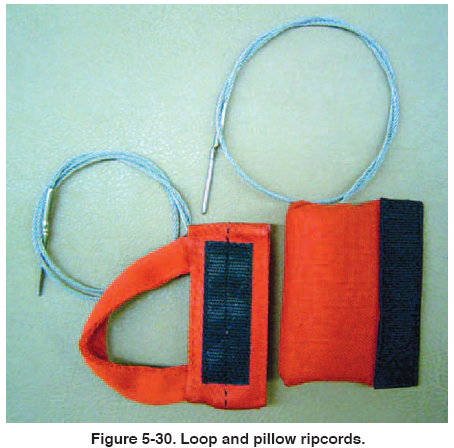Chapter 5
RIPCORD
All the areas mentioned in the pilot emergency parachute
section apply to the sport rig. In addition, some assemblies
utilize a ripcord which has a webbing loop handle,
or a “pillow” type handle similar to the 3-Ring® release
handle. [Figure 5-30] It is important that the rigger check
these handles for proper markings and fit to the assembly.
Make sure that there is sufficient slack in the cable to
allow no loading of the pin in any attitude or position that
the wearer may conceivably get into. Most, if not all of
these style handles utilize Velcro® to secure them to the
harness. Make sure the Velcro® is in good condition for
holding ability but not so much as to inhibit the pull
force.

Remember, while both the pilot emergency parachute and
sport piggyback assemblies share many areas in common,
each has peculiar requirements for its use. It is
important for the rigger to recognize these and handle
each system accordingly.
RIGGING AND REPAIRS
When the entire assembly inspection is complete, the
rigger will have a list of the discrepancies found during
the procedure. At this point, a determination must be
made on how to remedy these defects. For senior riggers,
certain remedial action may be outside the scope of their
certificate. If so, those riggers need to find an appropriately
certificated and rated rigger to do the work, or
return the parachute to the manufacturer for repair. In the
case of major canopy or harness work, this may be the
best solution regardless. Aside from the qualification limitations
of the rigger, the manufacturer may be better
equipped to perform major repair or overhaul. They have
the original patterns, templates, and design data as well
as the certified materials. In addition, their labor rate is probably less than what the rigger may charge the customer,
particularly if he/she has not done this repair
before. The factory has the experience and practice that
will result in the repair looking “just like new.” While
some riggers may look at any given project with anticipation,
they also need to look at what is best for the
customer.
Many times, the master rigger has a repair facility and
stocks it with the necessary materials. In most cases,
these materials come from sources with no traceability
as to their origin. The manufacturer is required to use
only those materials that have been tested, certified, and
approved to meet the standards of their quality control
system under the TSO system. During one recent routine
inspection and repack, the rigger found severe failure
of the harness stitching at the main lift web/leg strap
junction. Upon further examination, it was determined
that the thread used to sew the harness was not nylon.
The harness was returned to the manufacturer, who then
determined that the thread was indeed cotton and not
the required nylon. The thread broke at approximately
10 pounds vs. 45 pounds for 5-cord nylon. Further
investigation revealed that the harness was originally
manufactured with a harness size 3 inches shorter.
There were telltale marks left from where the original
harness was stitched. This modification was evidently
performed by someone who either was not qualified to
perform the work or had gotten a batch of the wrong
thread by mistake and did not recognize the difference.
Attempts to find out who did the alteration were unsuccessful.
The manufacturer repaired the harness at no
charge and returned it to the customer. To preclude this
type of problem, many professional riggers and lofts
establish good working relationships with the manufacturers
and procure certain materials from them. They
keep these marked and in a separate area, and use them
only on the appropriate projects.
Another area of concern is a master rigger who does
major alterations without proper approval of the manufacturer.
The rigger may do major repairs to return the
assembly to its original condition without further authorization
of the Administrator or manufacturer, but alterations
are another story. 14 CFR, subsection 65.129(e)
states that “No certificated parachute rigger may pack,
maintain, or alter a parachute in any manner that deviates
from the procedures approved by the Administrator or the
manufacturer of the parachute.” There are a number of
common alterations seen in the field. Among them are:
harness re-sizing, AAD installations, RSL retrofits, chest
strap relocation, and others. The manufacturer’s approval
can vary from a verbal message over the phone to a formal
engineering procedure complete with drawings and
specifications. If the work is done correctly, the truth
probably lies somewhere in the middle. If riggers want to
ensure they are following code, they should obtain some form of written approval from the manufacturer in whatever
form they will provide.
The bottom line is that the purpose of the system is to provide
an infrastructure that ensures the safety of the public.
Professional riggers strive to do the “right thing” both
morally and legally.
| 
